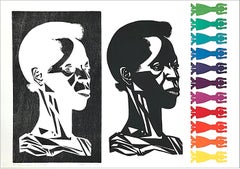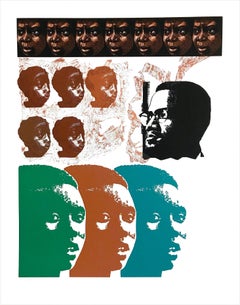Linocut Prints and Multiples
to
62
186
75
87
43
17
Overall Width
to
Overall Height
to
408
181
110
24
18
15
14
13
6
4
2
1
27
24
21
20
18
44
364
1
4
1
19
6
201
139
68
116
78
69
65
55
46
44
37
37
34
31
23
22
21
18
16
16
15
14
13
1,204
5,446
3,863
3,153
2,835
17
35
281
110
Style: Contemporary
Medium: Linocut
THERE IS A WOMAN IN EVERY COLOR Signed Relief Print, Black Woman Rainbow Figures
Located in Union City, NJ
THERE IS A WOMAN IN EVERY COLOR is a hand pulled limited edition relief print created using linocut, woodcut, and silkscreen printmaking techniques on white archival printmaking pape...
Category
Early 2000s Contemporary Linocut Prints and Multiples
Materials
Linocut
MALCOLM X SPEAKS FOR US Signed Linocut Portrait Head Black Civil Rights Activist
Located in Union City, NJ
MALCOLM X SPEAKS FOR US is a hand pulled, original limited edition relief print created using linocut printmaking techniques on white archival heavyweight Somerset paper 500 gsm., 100% acid free. Pencil signed, titled, dated by Elizabeth Catlett on the lower margin, embossed with printers chop mark lower left, print documentation provided. Printed at JK Fine Art Editions Co. MALCOLM X SPEAKS FOR US is an impactful graphic statement by the African-American woman printmaker and sculptor, Elizabeth Catlett, created as a tribute to the slain militant black activist...
Category
21st Century and Contemporary Contemporary Linocut Prints and Multiples
Materials
Linocut
Linocut prints and multiples for sale on 1stDibs.
Find a wide variety of authentic Linocut prints and multiples available on 1stDibs. While artists have worked in this medium across a range of time periods, art made with this material during the 21st Century is especially popular. If you’re looking to add prints and multiples created with this material to introduce a provocative pop of color and texture to an otherwise neutral space in your home, the works available on 1stDibs include elements of blue, purple, orange, green and other colors. There are many well-known artists whose body of work includes ceramic sculptures. Popular artists on 1stDibs associated with pieces like this include Mino Maccari, (after) Pablo Picasso, Rob Barnes, and Pablo Picasso. Frequently made by artists working in the Contemporary, Modern, all of these pieces for sale are unique and many will draw the attention of guests in your home. Not every interior allows for large Linocut prints and multiples, so small editions measuring 0.01 inches across are also available

